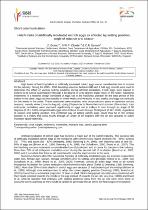| dc.contributor.author | Brand, Z | |
| dc.contributor.author | Cloete, S | |
| dc.contributor.author | Brown, C | |
| dc.date.accessioned | 2022-08-04T20:27:07Z | |
| dc.date.available | 2022-08-04T20:27:07Z | |
| dc.date.issued | 2020 | |
| dc.identifier.citation | Brand, Zanell & Cloete, Schalk & Brown, Christopher. (2020). Hatch traits of artificially incubated ostrich eggs as affected by setting position, angle of rotation and season. South African Journal Of Animal Science. 50. 607-612. 10.4314/sajas.v50i4.12. | en_US |
| dc.identifier.issn | 0375-1589 | |
| dc.identifier.issn | 2221-4062 | |
| dc.identifier.uri | 10.4314/sajas.v50i4.12 | |
| dc.identifier.uri | http://hdl.handle.net/10566/7694 | |
| dc.description.abstract | High levels of hatching failure in artificially incubated ostrich eggs cause considerable loss of income for the industry. In the 2015 - 2016 breeding seasons, between 846 and 1 549 egg records were used to determine the effect of various setting positions during artificial incubation. Fresh eggs were placed in trolleys in the setter that were turned automatically hourly through 60 degrees or 90 degrees. The additional treatments as factorial design included eggs set horizontally for five weeks in the setter; in horizontal position for three weeks and vertically for two weeks; and vertically for five weeks. These treatments were repeated over two production years to represent the seasons, namely winter (June to August), spring (September to November), and summer (December). Late embryonic mortalities improved significantly in eggs that were set to turn through 90 degrees (0.16 ± 0.02) compared with those set to turn through 60 degrees (0.28 ± 0.02), regardless of season and setting position. The preferred way of setting ostrich eggs would therefore be vertically in a trolley that turns hourly through 90 degrees with the air cell upwards to utilize incubator space optimally. | en_US |
| dc.language.iso | en | en_US |
| dc.publisher | AJOL | en_US |
| dc.subject | chick weight | en_US |
| dc.subject | embryonic mortalities | en_US |
| dc.subject | moisture loss | en_US |
| dc.subject | ostrich | en_US |
| dc.subject | pipping time | en_US |
| dc.title | Hatch traits of artificially incubated ostrich eggs as affected by setting position, angle of rotation and season | en_US |
| dc.type | Article | en_US |

